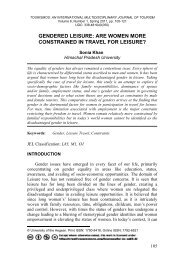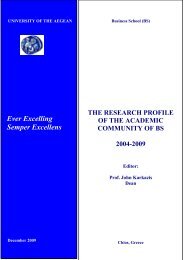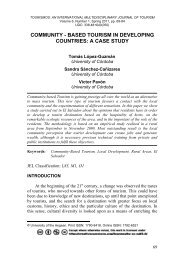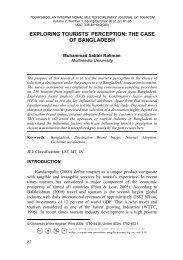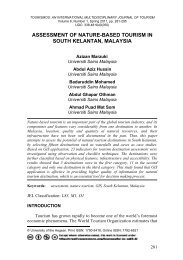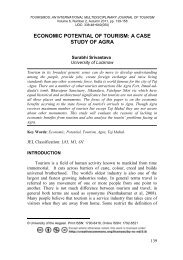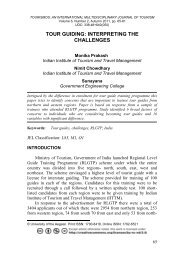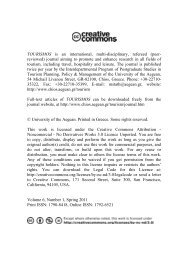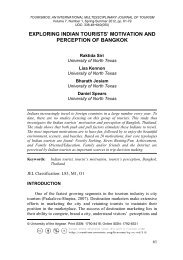COMMONS DEED
COMMONS DEED
COMMONS DEED
Create successful ePaper yourself
Turn your PDF publications into a flip-book with our unique Google optimized e-Paper software.
TOURISMOS: AN INTERNATIONAL MULTIDISCIPLINARY JOURNAL OF TOURISM<br />
Volume 6, Number 3, Winter 2011, pp. 13-36<br />
UDC: 338.48+640(050)<br />
earnings. The descriptive statistical analysis reveals that reporting<br />
earnings increases is not as relevant as reporting profits.<br />
Panel C reports the ownership structure of the Spanish hotels firms. It<br />
is noted that the introduction of this variable in our study entails an<br />
important reduction of the observations due to the database did not<br />
provide all the information. We can see that family ownership (36.44%) is<br />
dominant in Spanish hotel firms, followed by mixed shareholding<br />
structure (family, industrial or financial firms). Comparing profitable<br />
firms with non-profitable firms, it can be observed that family ownership<br />
involved in firm control is the usual way to manage Spanish hotel firms<br />
(31.01%) or they can be managed by a combination of family, industrial<br />
or financial firms (26.01%). We use this segmentation to test the<br />
incidence of ownership structure on the earnings benchmarks.<br />
The information related to audit (Aud) shows that 2,260 firms<br />
(28.39%) are audited-firms as opposite to 5,700 firms (71.61%) that are<br />
non-audited-firms (Panel C, last column). The presence of Big4 auditors<br />
are only 9.45% (Panel C, last column). It is noted that profitable firms are<br />
more audited than non-profitable firms.<br />
Table 2 shows the earnings distribution of net income building under<br />
different assumptions. In Panel A, net income is deflated by assets at the<br />
beginning of the year and the interval widths are calculated by Degeorge<br />
et al. (1999). Both frequency histograms present a kink at zero point being<br />
more pronounced in net income levels than in earnings changes. The<br />
significance of this irregularity is confirmed by a statistical test (p < 0).<br />
Panels B and C (Table 2) show some controls over histograms<br />
frequency. In Panel B, we follow the indication of Burgstahler and<br />
Dichev (1997) and Holland (2004) in order to determinate the interval<br />
widths. The interval widths are 0.01 for net income and 0.005 for changes<br />
in net income. The earnings‟ deflator is assets at the beginning of the<br />
year. In Panel C we do not use any deflator as previous paper showed that<br />
can generate a bias in earnings distributions. The interval widths are<br />
determinate using Degeorge et al‟s formula.<br />
All figures present a kink at zero point being more pronounced in net<br />
income levels than in earnings changes. The significance of this<br />
irregularity is confirmed by a statistical test (p < 0). The evidence<br />
indicates that avoiding loss hypothesis is more relevant to Spanish hotel<br />
industry than avoiding decrease in earnings. It is also noted that the<br />
interval widths and the deflator used generate differences in earnings<br />
distribution.<br />
21



